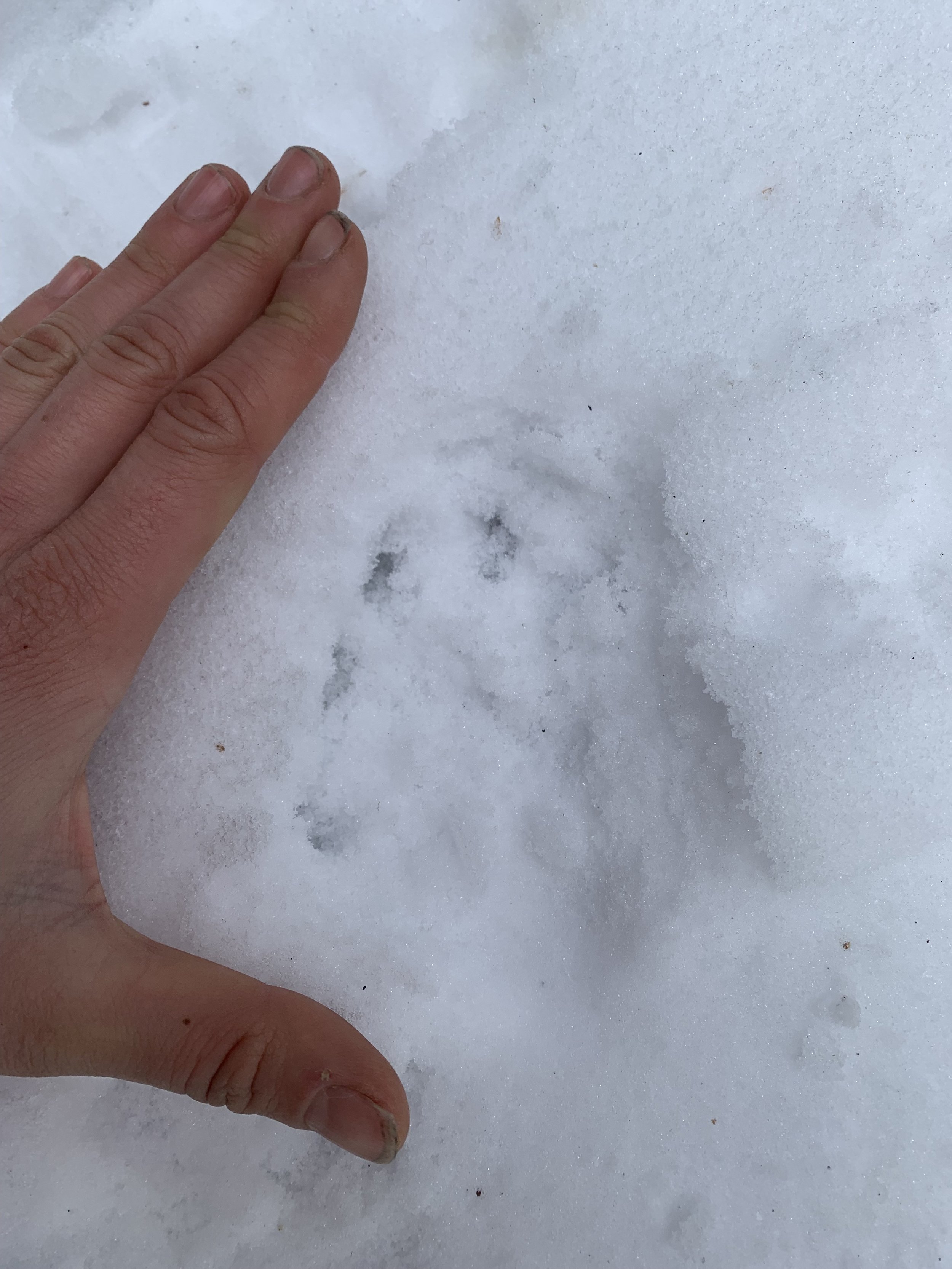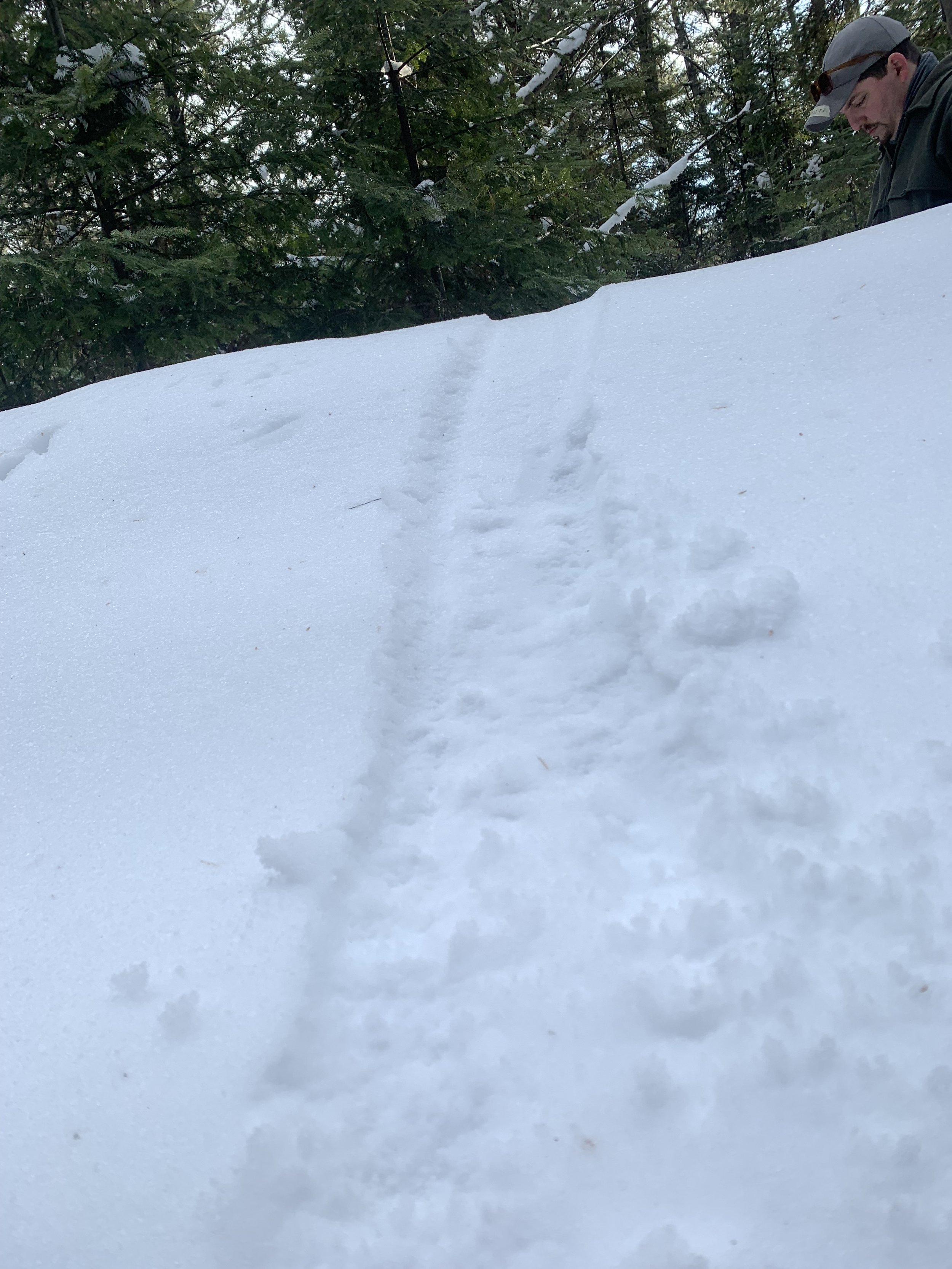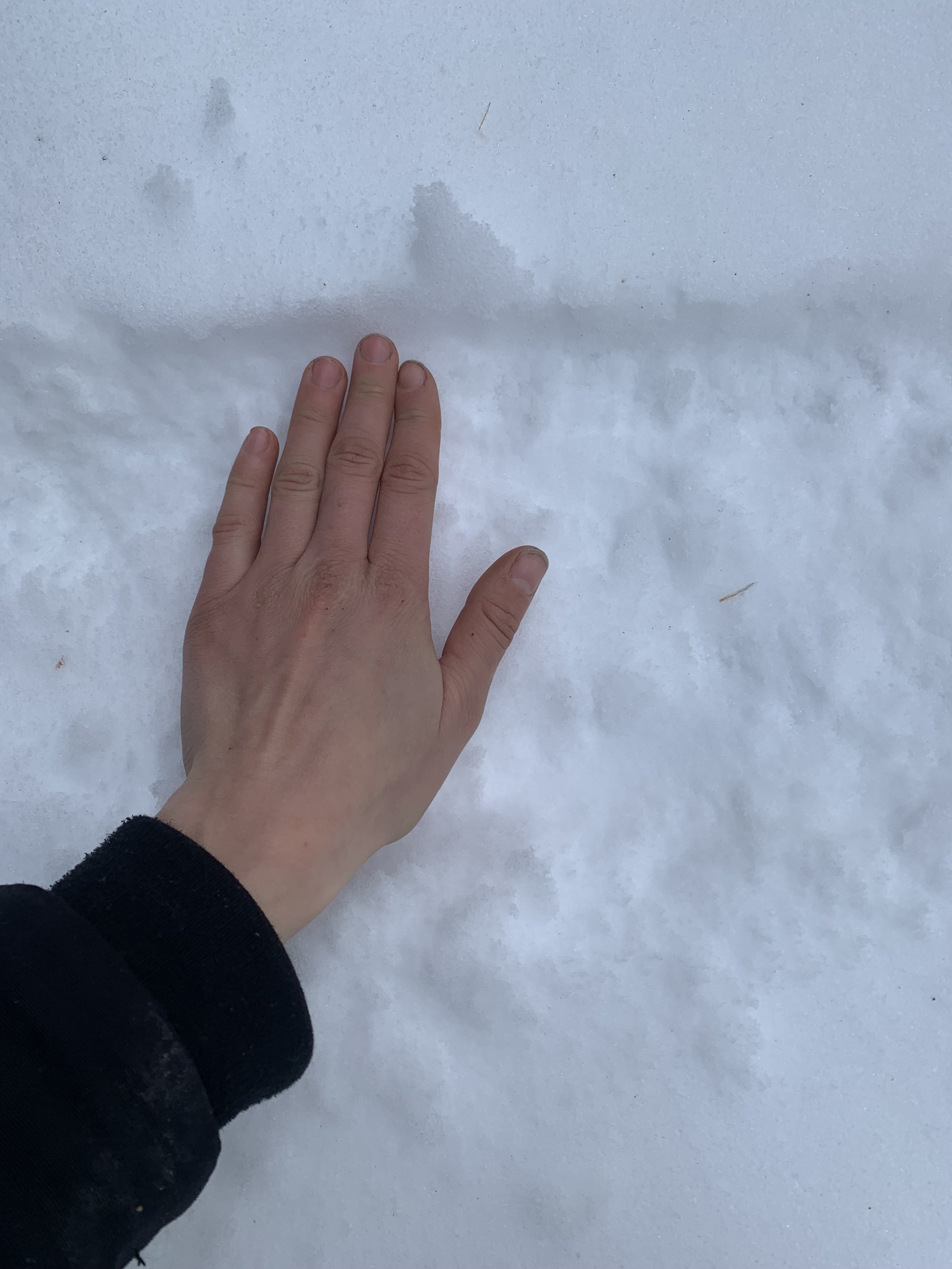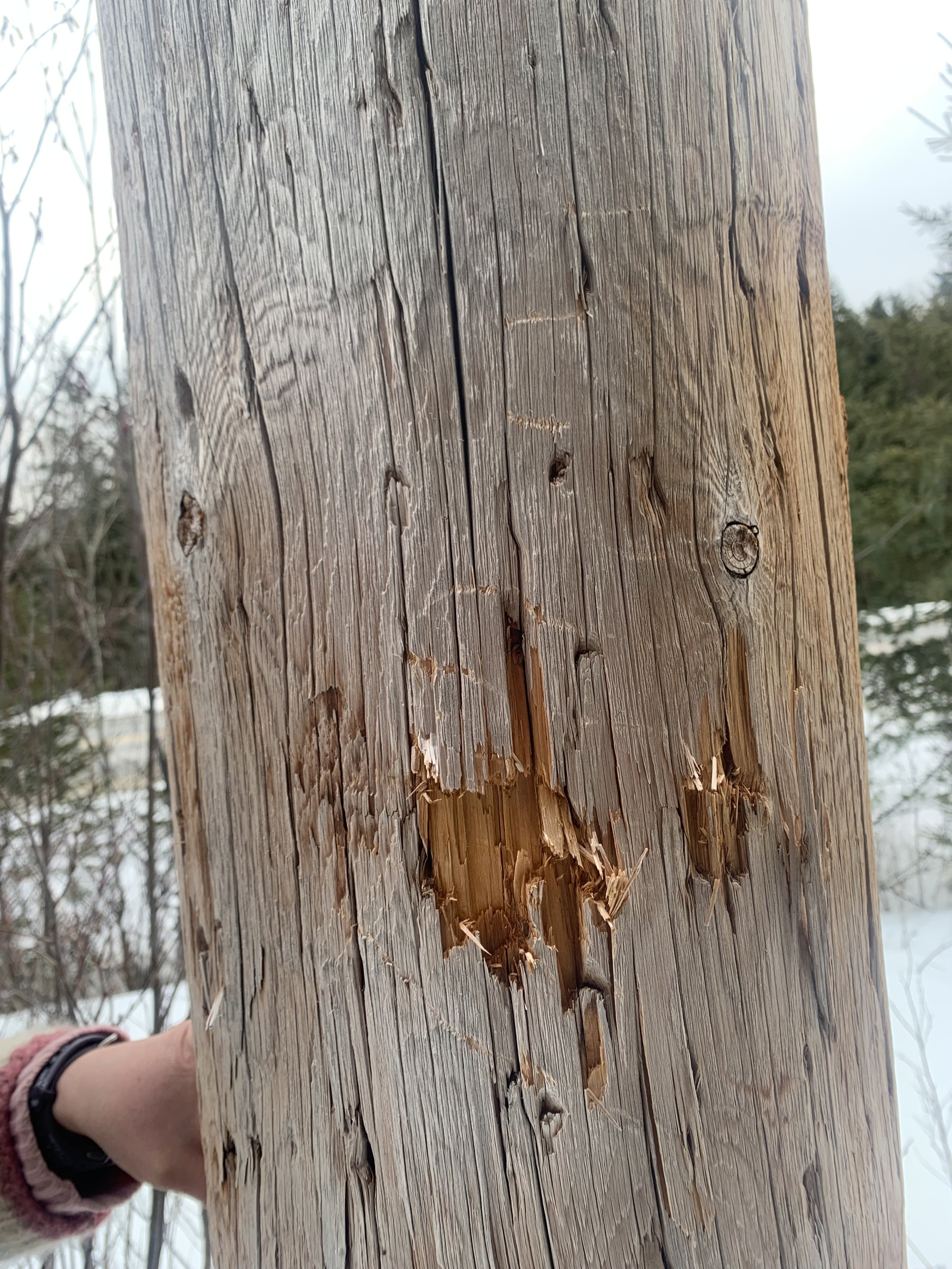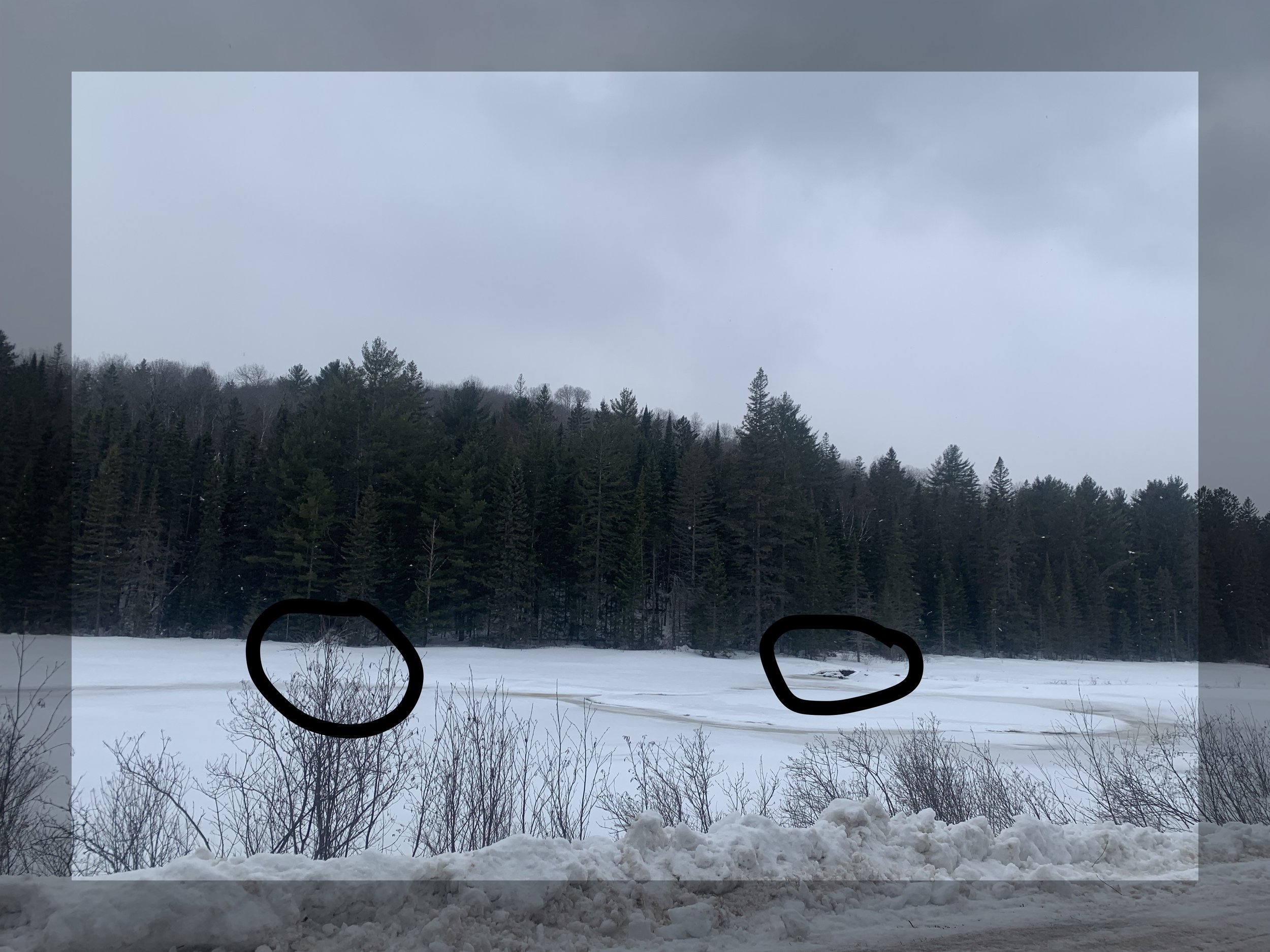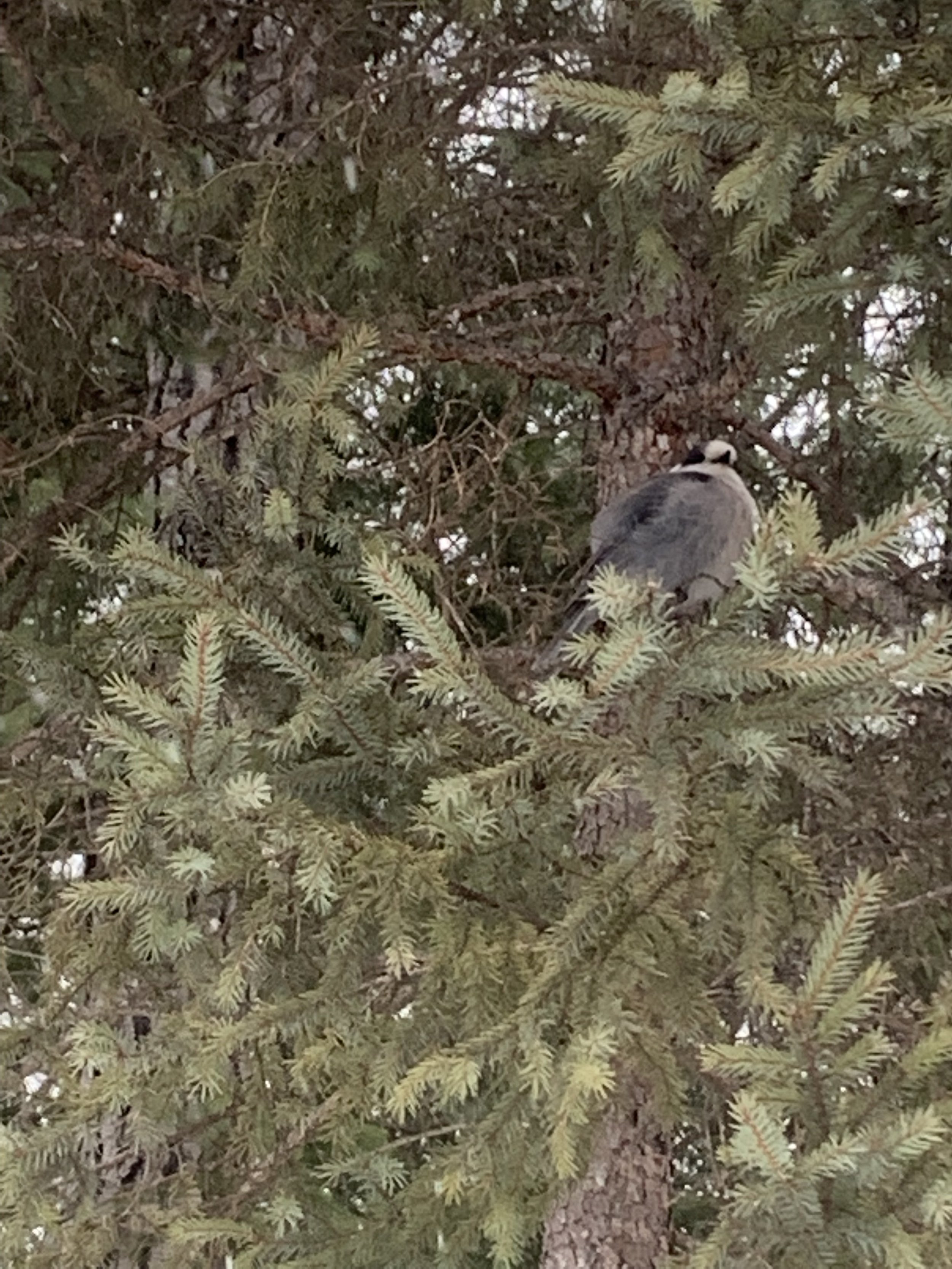Wildlife Tracking in Algonquin Park
with Earth Tracks Outdoor School
Sunday February 12 - Friday February 17, 2023
Date: Saturday February 18, 2023
Location: Guelph, Ontario- St Patricks Ward, home.
Time: 9:45 am
The trip back to Guelph was a success! A simple 4 hour drive back down through Dwight, Huntsville, back down the highway 11 to the 400 through Barrie, to the 9 that leads you to Orangeville, then dropping down and over through Caledon, towards Rockwood, then the highway 7 strait back into Guelph, to St Patrick’s ward, where Danielle, Byron and I call home.
It feels like a dream, but I know I have not only beautiful memories, but photos, and journal entries, to back up that it was all real. Now, finally some time to reflect on the beautiful week I just had up in Algonquin Park.
With my bags still not fully unpacked, id rather get on my laptop as an outlet for getting down my memories, so I may tell the stories while they are fresh, just like a good fresh track!
Monday Morning, 7 am. The first day of the trip.
This morning, I would go scouting. Scouting is where we go for a drive early in the day, to look for any spots along highway 60 in the park, where wildlife may have crossed the road, and of corse leaving tracks in the snow. Its not everyday I get to be out with the morning sunrise, as the world awakens, but today I was. Myself, Byron and Alexis, pulled over to get a better look at some tracks we saw, looking over a big lake, we witnessed the golden morning sun cresting up from the eastern edge of the park. Its cold, its beautiful, and im happy.
Alexis and Byron looking out across the frozen lake during our early morning scout. Alexis looks like he’s in mid conversation, and Byrons all blurry holding his monocular due to him pointing to something neat while I took this panorama.
Byron walking back to the truck. It was a beautiful morning.
We drove back to the cabin to meet the rest of the 15 person crew for 8:00 am. Have another cup of tea, second breakfast, pack our bags, and connect about the day. Our first stop would be at an otter slide we spotted along the road we take from the cabins down to Highway 60, that crossed over from one side to the other.
How in the world do you spot an otter slide? How does one know it is in fact, an otter slide?
The first world I will use here is pattern recognition.
Essentially what this means, is ones ability to pickup on, to notice, to see and interpret patterns.
From a simple pattern, of 1, 2, 1, 2, 1 2, or blue, green, blue green, to something like an otter slide.
Pattern recognition can also be ones ability to pick up on shapes or patterns that you may see in different places. For example, we all know the that the check mark for the Nike symbol, means and represents, Nike. Or that a stop sign, means stop. We see these symbols and shapes, and immediately can identify their meaning and what they represent. This same ability, can be applied in studying nature, and wildlife tracking, but by looking at things such as leaf patterns, or the walking pattern of an animal.
The first time I did this trip up in Algonquin in 2020, we tracked an otter, and I learned about otter slides.
So really, it was as simple as looking for that same, long, belly drag, slide-like print through the snow.
How do you know that its not a tree or a branch that left that long drag-like print? Or that your friend didn’t draw the line in the snow trying to play a bad joke? There are a few things that you can do to determine several factors to help verify that it is more likely than not, and otter slide.
A rule we followed through the week was, “No single-factor reasoning!” -that we cannot be saying, for example, that this slide-like shape is an otter slide, because it just is- more evidence is needed.
Enter the measuring tape!
An otter slide will usually have a width across, that is similar to the length of your hand, palm to finer tip. Give or take a bit since our hands will always be slightly different sizes, but usually the width of the track being about 5-6” (inches) wide, based on what I’ve seen, measured, and experienced so far.
If your measuring around 5-6”, that is 1 factor that would lead to suggest that this could possibly be, an otter slide. Another factor, is finding true tracks left by the animal. Follow the slide forward or backward, and look for places where the otter may have stopped sliding, and used its feet instead. We found this otter slide coming out of the forest, with a river in behind, and towards the driveway. Once the otter got to the driveway itself, it switched from sliding on its belly, using gravity to its advantage, to walking across the driveway to the other side, into the safety of the forest once again. On the driveway, we found a few of these tracks, or more specifically, foot prints, of what appears to be an otter.
Otter track with my hand as a size reference. What paw do you think made this track? Left? Right?
The otter slide, downhill, with Matt in deep contemplation at the top right.
My hand placed across the width of the slide. The length of my hand is about 6 inches.
The next thing we can do to determine another factor to back up, or to disprove that this is a true otter track, is the number of toes visible in the track. How many can you see?
Once we count the number of toes, this gives us more information to work with, to determine if this is or is not an otter.
To carry this information further, we must look to what we know about otters. How many toes do they even have? On one foot? On the front foot, the hind foot? How many toes will even show up in a track?
These are a few questions we can use to clarify if we are on an otter track or not.
If we don’t know how many toes an otter has, we can look it up in a good animal ID book. That is if you don’t happen to have a willing otter with you who will let you count their toes.
In Donna Naughtons book, The Natural History of Canadian Mammals, we can reference that the Northern River Otter, has 5 toes, on both the front and hind foot. In the above photo, it may be most easily seen to have 4 toes, based on the most obvious impressions that are darker, yet there is 5, with the top right toe imprint being filled in by snow from the track itself falling in. 5 toe impressions, 5 toes on an otter! This factor is verifiable, and true. A final factor that we used here, is the measurement of the track, of the foot prints. This we will find by measuring the length, and the width of the print. Measuring length, from heel to toe, and width, simply from one side of the tracks width to the other. Again, in Donna Naughton’s book, we read that the Northern River Otter will have a left hind track that measures 2 1/8 “- 4” long, and 2 1/8- 3 3/4” wide, and a left front track that is 2 1/8”- 3 1/4” long, by 1 7/8”- 3” wide. If we measure this track and we get measurements that are within those ranges, for front and hind tracks, than we can backup the idea that this is a river otter.
By using multiple factors to reason that something could be what we think it is, we can narrow in on why it is, what it is, or how it is, what it is. Using evidence and reason that is sound, realistic, and reputable. There are many more factors that I could cover here, to take things that much further to determine what animal made the track, but we will save those for another moment.
After we finished up at the otter slide, the group broke into two smaller groups, and we would both go to separate locations that were chosen from the morning scouting, nofollow a set of relatively fresh tracks into the woods, to see what we could see! My group, would go after what we through were fresh wolf tracks, and little did we know that this was a door to learning a whole lot more! After only about 15 minutes, we realized that these were more likely than not, not wolf tracks. They did have a large paw shape to them, the trail width looked similar to a wolf, but other factors were causing us to think otherwise. After I very in depth assessment of the tracks, and a good group discussion, I learnt that these were more likely tracks belonging to the Fischer. A creature that I do not know very well, as they are more rare where I live. A creature that is smaller, and shorter than a wolf. Please know that I am relatively new to tracking and learning about wild animals. I love love love it, and, I still feel like a bit of an ignorant baby that knows, nothing!
We continued forth, on what we were imagining was likely, a Fischer. A few more steps into the forest, and another person in our group finds a spot where this animal slid downhill on its belly. Do fishers slide on their belly? Hold on, is this an otter?! More questions were born. But still, not enough factors to determine clearly, who’s tracks we were actually following. Snowshoeing a bit further, the tracks led down to a small creek, where they did not go into the water, but crossed the creek, via a small natural bridge of ice and snow build up over a log that was across the creek. This animal, chose to cross the creek by staying out of the water versus going into the water. We took time to check out this great moment, that would inform us with more information about who’s tracks we are following. Did the animal cross the creek, and then walk down into the water from the other side? Did it stop to take a drink? My friend Diana was bold enough to walk in the creek with her amazing knee high winter rubber boots! She was not seeing much for tracks or sign suggesting that the animal interacted with the water at all. Perhaps this is not an otter... otters are an aquatic animal, but these tracks do really avoid the water. We all opted to cross the creek via the natural bridge, to follow the tracks further.
We looked around, and sure enough, Byron soon discovered, some scat. Enter another factor to help determine what species of animal, you may be looking at: scat!
Scat equals more information!
This small scat would soon be surrounded closely by several full grown adults. I find a bit of humour in this. Imagine- Grown human adults, encircled around a small scat only a few inches long. We proceeded to use sticks, to break apart this scat, to look into what was this creature eating. The contense of the scat would inform us of who this scat belongs to. We found small bits of bone, and some pieces of what looked a bit like what could maybe be fish scales... or what also looked like pine bark, a small small flake, from a red pine tree. This animal is clearly a carnivore, or omnivore, due to the bones, but it still wasn’t clear on who made this scat. Further still, we can take measurements of the scat, length and width, similar to measuring a track or foot print, to help determine who’s scat this was. The scats size and shape, also pointed us towards not wolf, potentially otter, and possibly still, Fischer.
We followed the tracks from this scat further up through the forest, heading uphill. They came to a new animal track, that got us all excited, as it looked like a bigger, heavier animal. We decided to have lunch.
This larger bigger track, led us to more tracks just like it. Based on the width of the trail, the depth of the impressions in the snow or heaviness of this animal, based on the size of the foot prints, based on the type of print in the snow, and the claw marks, that these were wolf tracks. I opted to wander around on my own, but still relatively close to the group, and within audible range. I began to find more wolf tracks; and more, and more, and they appeared to all come closer together and more frequent within this one main area. It was at the top of the hill, where it levelled out and looked out over a lake. I became more and more excited. I had this feeling, that something was about to happen. I thought, this must kind of be what its like for a wolf right before it catches some prey! My heart beat and my adrenaline picked up, my awareness was heightened, and my senses sharp. I was snowshoeing faster, and really feeling into the environment around me, like an internal radar system. Then, I spotted something.
A hole! This didn’t feel like what I was truly feeling excited about, but this was a particularly special hole, or more like an indentation. I got closer to this, what we will call for now, hole. I knelt down. It was at the edge of the hill top, where the land was a good incline downwards to my left. My first action, was to take off my gloves. There was a light dusting of snow on the surface of this indentation. With my bare hand, I brushed my hand flat against the surface, brushing the snow away, which revealed visually, as well as being able to feel physically, a hard, cold, icy surface. This indentation, had a very evident ice layer. I had seen things such as this before in the snow, such as a deer bed, which is similar, a lot bigger, but never this size yet. It was very round visually. I took a measurement. It was 16” - 18” wide, and about 2 ft or 24” long. I knew I had followed wolf tracks to this indentation, and so one would imagine that this would be made, by a wolf. Yet, it looked so small, and so round to me, and I had never found nor seen a wolf bed before. I noticed movement in the woods not far from me, I called out loud, “Byron…”.
Soon enough I had a Byron with me, followed soon too, by a Lee, another one of the adults who was with us for the week, leading and teaching on this trip. I shared with Byron and Lee about what I found, and what I was thinking. I shared my measurements of the funny indentation. We also discovered a spot beside this, where we found scat, scat with fur, as well as a piece of Lungwort Lichen… odd. Based on the tracks leading to it, based on the size, roundness, and the scat, we determined that this was in fact a wolf bed! Dang. Wow! My first wolf bed! I was amazed that wolf beds are actually rather small looking. I understand wolfs to be bigger than coyotes, and so this seemed very odd to me that a canine as big as a wolf would bed down, and curl up in such a way that made an indentation in the snow that is so small. It turned out that the others in our group had found 2 more wolf beds in another part of the forest not too far away. They too, also measured a similar length and width. It was also possible to imagine how the wolf had been curled up. You could visually locate where the wolfs backside would have been, and even perhaps where the front legs may have been placed. That was a lot of hype for the day. Tracks, scats, wolf beds x 3! We called it a day and made our way back down the hill, towards the main road, highway 60. But before making it to the car, we had to check out a telephone pole along the roadside, for potential bear signs.
Sure enough, there were some on this telephone pole.
This pole shows the location where a bear would have likely bit the pole. When we looked close we could see teeth marks of the bears teeth pulled across the grain of the wood. Above the central bite mark you can also notice claw marks, running across the grain.
Bear fur stuck on the telephone pole. Some of the strands have been bleached by the sun. This photo was edited slightly to enhance the hairs.
Once we returned back to the cars, half our crew would return back to the cabin in 1 car, while the other half wold drive up Opeongo Lake Road in the second car, to see if we could feed the grey jays! This was one of my friend Diana’s goals for the week, to feed a grey jay by hand.
We drove up the road, and another vehicle was coming down the road. They stopped, rolling down their window, and said aloud “Are you looking for the otters?!” We were not looking for the otters. We decided to go along with it even still. “Yeah, where are the otters?!” We replied. The woman in the vehicle shared that if we kept going up the road a bit were is a big open water way to the left, with another car or two stopped there, you’ll see them. We thanked this kind and generous woman for sharing what she had, and up the road we went. Moments later, we saw the water way to the left, and a few cars on the road before us. A man with a giant camouflage photography camera was set up, watching the otters too. Looking out, there were 2 otters! Each at a different location, but both hanging out close to a hole that led into the water. They would hangout on the surface of the ice, playful behaviour, and then suddenly jump back into the hole, head first, with the long sleek tail, sliding in after it almost like a fish. In and out of the hole they went. Perhaps with a sort of awareness for all the funny humans watching them just be otters, and another sense of them perhaps of not being concerned about us at all. They were a healthy distance away, a special opportunity! We watched them for a good 10 minutes. It was snowing now.
With another special moment shared, we climbed back into Alastair’s car, and drove up further to the bird feeding spot. Diana handed out a bit of bird seed she brought along, and we stood out in the snow, our arms out stretched in hopes the chickadees or grey jay may come by. There were birds flying about, little chirps could be heard, but no action. After standing still for a while, and imagining a Pine Marten climbing about in the trees before me, I realized there was a very fluffed up bird sitting in the tree right in front of me. It was a Grey Jay!
The grey jay is also known as a Whiskey Jack, (I don’t know why, yet!) or a Canada Jay. I studied the fluffy bird. It looked very content, and likely appeared a lot bigger than they actually are, with its feathers all fluffed up. It moved its head a bit, looking around, but really seemed to have no interest in these humans bearing seed. Knowing we had to get back soon to prepare for dinner, I placed my seed on the ground, and into the car we went. Thank you Grey Jay!
As soon as we arrived back at the parking area in front of the main cabin, we noticed others were out in the parking lot doing something funny. We quickly were informed that there was a Pine Marten hanging out right by the cars! We carefully got a bit closer, and watched as this adorable looking creature, almost like a mini fox, climbed and walked along the snow piles in the parking area. It ran off in behind the portable, and into the woods. I had never seen this animal in my life. It was amazing. The Pine Marten, or the American Marten, or Martes Americana, was my focal species for the week. Which meant that for the week this was the animal that I would study and get to know a bit better with help from many, many books about mammals, tracks, other folks, and the Marten itself.
Getting to see your focal species that you’ve never seen before with your own two eyes… I was happy.
The two spots we saw the otters. In both locations there was an hole in the ice. The otters both stayed close to their hole of safety, and continually dove into, and climbed out of it.
The far left otter. Doing otter things.
The far right otter. Locate the dark mass in the snow in the centre of this photo: that smaller dark mass beneath and to the left of the larger dark mass is the otter standing on the ice. Likely also doing otter things.
Can you spot the Grey Jay in the evergreen tree? Complete with my finger tips, of my seed holding hand, and falling snow.
This Grey Jay seemed to feel unthreatened. I was lucky enough to get this close up shot.
Since the Pine Marten ran off, folks redirected to dinner prep mode. Into the main cabin we went! Moments later Diana and I were leaving the main cabin, im not sure why in this moment. As we began walking down the path from the cabin to the parking area, Diana and I were talking about the Pine Marten. Just thinking about it together out loud. As we got closer to Alexi’s truck, which was parked a bit closer to the cabin, all of a sudden I felt myself being pulled backward. What was happening!?!
Diana had forgot my name, and instead, grabbed the handle on the top of my backpack on my back, and yanked me back in a quick halt. I didn’t know why yet, but I was okay with it. This all happened within a matter of seconds, as she quickly directed my attention to the Pine Marten, who was walking around by Alexis’s truck. We stood completely still. Watching this cute adorable little being, meander around the truck bed, occasionally jumping up into a big pine tree that was right behind the truck. There were 2 big blue water carrying jugs on the ground at the back of the truck, with the tuck bed being closest to us.
Based on the Martens behaviour, how it was moving, back and forth, looking to the truck, back to us, and then to the tree, studying and analyzing the moment, the overall situation, perhaps analyzing potential danger VS something that might be worth potential danger, I had this notion that it wanted to get in the truck bed.
Seconds later, the Marten stealth-fully jumped up onto the blue water jug, and up onto the edge of the truck bed, and down into the truck bed. It must have gabbed something in its mouth, then climbed back out and ran off. All I remember next is Diana walking up to the truck bed, looking in, and grabbing what was there, that had attracted the Marten to begin with: a bag of suet! Alexis had brought up suet, or animal fat, for baiting in sight of the trail cameras. I suppose he forgot it in the truck bed, so Diana took the suet, and brought it safely indoors. What an intelligent being that Pine Marten. But don’t be fooled! The Pine Marten may appear cute and all, but it is a powerful little being. They can climb trees, and have wrists like humans that allow them great skill with climbing. Never mess with a Pine Marten! Their cuteness will over throw you!
The freshest Marten tracks ive ever seen.
The Pine Marten. Potentially planning its entry into the truck bed.
Before it all happened. When the Marten does jump up to the truck bed, you can hear my voice in the background saying “I knew it I knew it!!”. Confirming my notion and prediction that it wanted to get into the truck bed.
That was our Monday!
If you have any questions, comments or to correct any facts, send an email to connect@windandrain.ca
We would love to hear from you!
If you’d like to read about the rest of the week, you can get to Tuesdays write up just below this, or scroll back to the top and select the day of the week you are interested in.
I highly suggest reading them all in order of the days of the week.




